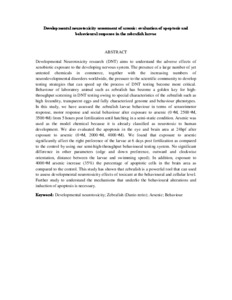Citation
Abu Bakar, Noraini and Mohd Sata, Nurul Syafida Asma' and Wan Ibrahim, Wan Norhamidah
(2015)
Developmental neurotoxicity assessment of arsenic: evaluation of apoptosis and behavioural response in the zebrafish larvae.
Malaysian Journal of Microscopy, 11 (Supp 1).
pp. 41-42.
ISSN 1823-7010
Abstract
Developmental Neurotoxicity research (DNT) aims to understand the adverse effects of xenobiotic exposure to the developing nervous system. The presence of a large number of yet untested chemicals in commerce, together with the increasing numbers of neurodevelopmental disorders worldwide, the pressure to the scientific community to develop testing strategies that can speed up the process of DNT testing become more critical. Behaviour of laboratory animal such as zebrafish has become a golden key for high-throughput screening in DNT testing owing to special characteristics of the zebrafish such as high fecundity, transparent eggs and fully characterized genome and behaviour phenotypes. In this study, we have assessed the zebrafish larvae behaviour in terms of sensorimotor response, motor response and social behaviour after exposure to arsenic (0μM, 2500μM, 3500μM) from 5 hours post fertilization until hatching in a semi-static condition. Arsenic was used as the model chemical because it is already classified as neurotoxic to human development. We also evaluated the apoptosis in the eye and brain area at 24hpf after exposure to arsenic (0μM, 2000μM, 4000μM). We found that exposure to arsenic significantly affect the right preference of the larvae at 6 days post fertilization as compared to the control by using our semi-high-throughput behavioural testing system. No significant difference in other parameters (edge and down preference, outward and clockwise orientation, distance between the larvae and swimming speed). In addition, exposure to 4000μM arsenic increase (35%) the percentage of apoptotic cells in the brain area as compared to the control. This study has shown that zebrafish is a powerful tool that can used to assess developmental neurotoxicity effects of toxicant at the behavioural and cellular level. Further study to understand the mechanisms that underlie the behavioural alterations and induction of apoptosis is necessary.
Download File
![[img]](http://psasir.upm.edu.my/75597/1.hassmallThumbnailVersion/Developmental%20neurotoxicity%20assessment%20of%20arsenic%20evaluation%20of%20apoptosis%20and%20behavioural%20response%20in%20the%20zebrafish%20larvae.pdf)  Preview |
|
Text (Abstract)
Developmental neurotoxicity assessment of arsenic evaluation of apoptosis and behavioural response in the zebrafish larvae.pdf
Download (51kB)
| Preview
|
|
Additional Metadata
| Item Type: |
Article
|
| Divisions: |
Faculty of Science |
| Publisher: |
Microscopy Society Malaysia |
| Notes: |
Proceedings of the International Anatomical and Biomedical Scientific Conference (IABS), 18-20 August 2015, Universiti Putra Malaysia |
| Keywords: |
Developmental neurotoxicity; Zebrafish (Danio rerio); Arsenic; Behaviour |
| Depositing User: |
Nabilah Mustapa
|
| Date Deposited: |
12 Nov 2019 02:29 |
| Last Modified: |
12 Nov 2019 02:29 |
| URI: |
http://psasir.upm.edu.my/id/eprint/75597 |
| Statistic Details: |
View Download Statistic |
Actions (login required)
 |
View Item |

